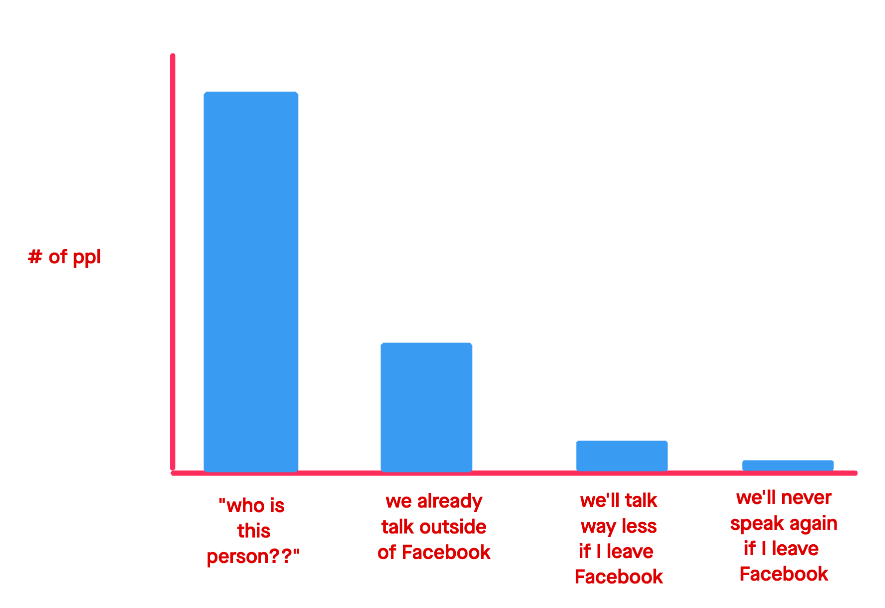Facebook friends, Twitter friends, LinkedIn friends
December 2022
In the month-ish since I quit using Twitter and LinkedIn I’ve had a chance to reflect on the kind of relationships I have with people on those platforms. Spoiler alert: Mostly non-relationships.
Let’s rewind a bit. In 2016 I decided to stop using Facebook, and at the time it felt like a bold, revolutionary act. But as I shook off the cobwebs I noticed that several of the people around me … also didn’t seem to be on Facebook.
I started asking about that, and the unanimous response I received was: “I’m on there but I just use it to message like one or two people.” A variation on this: “My grandma doesn’t text.”
This got me thinking more about the specific individuals I most interacted with when using Facebook, and I realized it was a similarly arbitrary group. Leaving the app meant losing touch with the one or two people who simple weren’t reachable through email, phone calls, text messages, or meeting in real life. The majority of my FOMO was driven by a handful of users.
Last month when I decided to stop using LinkedIn, I knew I didn’t want to delete my account. I’ve got like 1,000 connections on there! It would be silly to throw them away.
But over the course of the last week, I scrolled through all 1,000. In the process (it took hours), I found three types of connections:
1. “I have no clue who this person is” or “I have no interest in talking to them.” This was the case about 90% of the time.
2. “I am (or easily could be) in regular contact with this person outside of LinkedIn” I found this applies to most of the folks who didn’t fall into the first group. If we hadn’t chatted lately, I took the opportunity to send them a text or email saying hi and checking in. But there was one more tiny group:
3. “I probably won’t talk to this person anymore if I don’t use LinkedIn.” Once again, a handful of folks who don’t really want to keep in touch via other means, but who spend a ton of time on LinkedIn. They post often, they respond to DMs immediately. I will miss them, a little bit, but I will be okay.
Over the next few weeks, I’m planning to repeat this process with the several hundred people I follow on Twitter. I expect I’ll find the same thing - no clue who most of them even are; lots I can find a way to stay in touch with; a few I’ll never speak to again, unless I come back to Twitter.
It’s fine.
What’s not fine, now that I think about it, is letting something as important as who I interact with the most be determined by who spends the most time logged in to the platform I happen to be using.
If I choose to use Facebook, or Twitter, or LinkedIn, I choose to have a feed dominated not by the people I find the most interesting, but by people who are the most successful users of the platform. When I share something, I choose to hear back not from the people whose opinions I most value, but from the people who spend the most time logged in.
The phrase “social media” is a misnomer. “Medium” simply signifies “a means of communication” - but these platforms are not just ways to connect. They’re sorting algorithms, that distribute your attention for you. By deciding what topics and takes you see more of, sure. But also by determining what accounts people you see more of.
If in fact we are the average of the 5 people we spend the most time with, social media apps are doing their part to ensure that we’re all at least 1/5 “Very Online Epic Poaster.”
You can always log off! The catch is that it requires more work to maintain relationships outside of a social media feed. You might find that you have to organize events, or even dedicate an hour each week to reach out to people deliberately.
It takes time, yes - but only a few hours a week. Compare that with 2+ hours a day :)
So far it’s going great for me. If you decide to try it, I’d love to hear about it.
